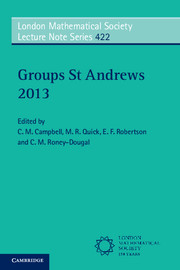Book contents
- Frontmatter
- Contents
- INTRODUCTION
- Approximate subgroups and super-strong approximation
- Width questions for finite simple groups
- Profinite properties of discrete groups
- GL(n, Z), Out(Fn) and everything in between: automorphism groups of RAAGs
- Permutation groups and transformation semigroups: results and problems
- New progress on factorized groups and subgroup permutability
- A survey on the normalizer problem for integral group rings
- A survey on Clifford-Fischer theory
- A generalisation on the solvability of finite groups with three class sizes for normal subgroups
- Automorphism groups of non-orientable Riemann surfaces
- What are the C2-groups?
- Resurrecting Wells’ exact sequence and Buckley's group action
- Recent work on Beauville surfaces, structures and groups
- Something for nothing: some consequences of the solution of the Tarski problems
- The groups of projectivities in finite planes
- On the relation gap and relation lifting problem
- Some results on products of finite subsets in groups
- Formal languages and group theory
- On the Castelnuovo-Mumford regularity of the cohomology of fusion systems and of the Hochschild cohomology of block algebras
- Recent advances on torsion subgroups of integral group rings
- On finite groups with small prime spectrum
- Solvability criteria for finite loops and groups
- The rational subset membership problem for groups: a survey
- A survey of Milnor laws
- Capable p-groups
- On the normal structure of a finite group with restrictions on the maximal subgroups
- Certain monomial characters and their normal constituents
- Recognition of finite quasi-simple groups by the degrees of their irreducible representations
- Generalized Baumslag-Solitar groups: a survey of recent progress
- Zeta functions of groups and rings – recent developments
A survey of Milnor laws
Published online by Cambridge University Press: 05 September 2015
- Frontmatter
- Contents
- INTRODUCTION
- Approximate subgroups and super-strong approximation
- Width questions for finite simple groups
- Profinite properties of discrete groups
- GL(n, Z), Out(Fn) and everything in between: automorphism groups of RAAGs
- Permutation groups and transformation semigroups: results and problems
- New progress on factorized groups and subgroup permutability
- A survey on the normalizer problem for integral group rings
- A survey on Clifford-Fischer theory
- A generalisation on the solvability of finite groups with three class sizes for normal subgroups
- Automorphism groups of non-orientable Riemann surfaces
- What are the C2-groups?
- Resurrecting Wells’ exact sequence and Buckley's group action
- Recent work on Beauville surfaces, structures and groups
- Something for nothing: some consequences of the solution of the Tarski problems
- The groups of projectivities in finite planes
- On the relation gap and relation lifting problem
- Some results on products of finite subsets in groups
- Formal languages and group theory
- On the Castelnuovo-Mumford regularity of the cohomology of fusion systems and of the Hochschild cohomology of block algebras
- Recent advances on torsion subgroups of integral group rings
- On finite groups with small prime spectrum
- Solvability criteria for finite loops and groups
- The rational subset membership problem for groups: a survey
- A survey of Milnor laws
- Capable p-groups
- On the normal structure of a finite group with restrictions on the maximal subgroups
- Certain monomial characters and their normal constituents
- Recognition of finite quasi-simple groups by the degrees of their irreducible representations
- Generalized Baumslag-Solitar groups: a survey of recent progress
- Zeta functions of groups and rings – recent developments
Summary
Abstract
The group laws which are not satisfied in product-varieties ApA for any prime p will be called, after F. Point, the Milnor laws. Let G be a 2-generator relatively free group defined by a nontrivial law w ≡ 1. We show that this law is the Milnor law if and only if G’/G’’ is finitely generated. Moreover, the properties G’ = G’’ and G’ is finitely or infinitely generated, allow us to split the Milnor laws for three disjoint classes. We describe their properties.
Introduction
We denote by F = _x, y_ the free group of rank 2 and by F∞ the free group on X = ﹛x1, x2, … ﹜. A word w = w(x1, x2, … , xn) is called a law for a group G if w(g1, g2,… , gn) = e for all g1, g2, …, gn in G. The law w can be written as w ≡ 1. We denote [x, y] = x−1y−1xy = x−1xy, [x,0y] = x, and [x,n y] = [[x,n−1 y], y].
A variety of groups is the class of all groups satisfying every law in a given set of laws (see [20] Chapter 1). Each variety is defined by a verbal subgroup V ⊆ F∞ and consists of all groups G satisfying V (G) = ﹛e﹜.
By we denote the variety of all abelian groups of a prime exponent p, by A – the variety of all abelian groups. Nc denotes the variety of nilpotent groups of class ≤ c and Be – the variety of all groups of exponent dividing e.
In the following section we describe different types of laws, such as positive laws, pseudo-abelian laws, R-laws, Milnor laws. The corresponding varieties have similar names. The aim of the paper is to show that the commutator subgroup G’ of a 2- generator free group G in the variety defined by a law w ≡ 1 is responsible for the crucial properties of the law.
- Type
- Chapter
- Information
- Groups St Andrews 2013 , pp. 390 - 398Publisher: Cambridge University PressPrint publication year: 2015



